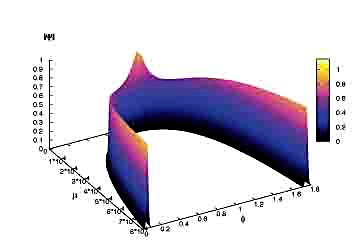Mathematical Model suggests pre-Big Bang physics
According to Einstein’s general theory of
relativity, the Big Bang represents The Beginning, the grand event at which not
only matter but space-time itself was born. While classical theories offer no
clues about existence before that moment, a research team at Penn State has used
quantum gravitational calculations to find threads that lead to an earlier
time.

The figure represents our expanding universe as the right branch of the arc. Our time now is located at the 1.8 grid mark on the right side of the drawing. According to Ashtekar’s team’s calculations, when looking backward throughout the history of the universe, ‘time’ does not go to the point of the Big Bang but bounces to the left branch of the drawing, which describes a contracting universe.
“General relativity can be used to describe the universe back to a point at which matter becomes so dense that its equations don’t hold up,” says Abhay Ashtekar…at Penn State. “Beyond that point, we needed to apply quantum tools that were not available to Einstein.” By combining quantum physics with general relativity, Ashtekar and two of his post-doctoral researchers, Tomasz Pawlowski and Parmpreet Singh, were able to develop a model that traces through the Big Bang to a shrinking universe that exhibits physics similar to ours.
In research reported in the current issue of Physical Review Letters, the team shows that, prior to the Big Bang, there was a contracting universe with space-time geometry that otherwise is similar to that of our current expanding universe. As gravitational forces pulled this previous universe inward, it reached a point at which the quantum properties of space-time cause gravity to become repulsive, rather than attractive.
“Using quantum modifications of Einstein’s cosmological equations, we have shown that in place of a classical Big Bang there is in fact a quantum Bounce,” says Ashtekar. “We were so surprised by the finding that there is another classical, pre-Big Bang universe that we repeated the simulations with different parameter values over several months, but we found that the Big Bounce scenario is robust.”
The infinite regression of a material universe still stands as the most logical model. Too bad Fred Hoyle isn’t still around to examine contemporary physics that supports his disagreement with the model he coined as the “Big Bang”. In the late 1940’s.
Posted: Mon - May 15, 2006 at 08:04 AM